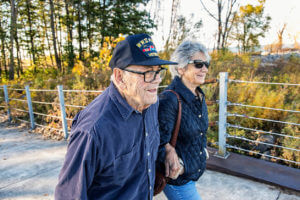
The legacy of the Cold War era extends to impact individual lives today. The Atomic Veterans and Downwinders Compensation Programs stand as a belated yet crucial acknowledgment of this impact. They have been designed to support those exposed to the perils of nuclear testing — military personnel and civilians alike. These programs offer a measure of redress for the health adversities they endured.
A Quick Look at the Atomic Veterans and Downwinders Compensation Program
The Atomic Veterans Compensation Program acknowledges the sacrifices of military personnel who were part of nuclear tests or who were assigned to clean up radioactive sites. Similarly, the Downwinders Compensation Program addresses the needs of civilians who lived in areas where nuclear testing occurred. These programs provide crucial recognition and financial assistance to those who have developed health issues due to their exposure.
The History Behind the Compensation Program
1945 to 1962 was a time of war and weapons. During this period of time, the U.S. conducted more than 200 atmospheric nuclear tests, many of which occurred in Nevada. These tests released significant amounts of radioactive materials into the atmosphere, unknowingly affecting thousands of people. Among those affected are military personnel (atomic veterans) involved in the tests and residents living downwind of the test sites (downwinders)
After years of advocacy and growing public awareness, the U.S. government took legislative action. The Radiation Exposure Compensation Act (RECA) of 1990 marked a pivotal moment, offering an apology and monetary compensation to those affected. This act was a significant step in acknowledging the health impacts of the government’s nuclear testing program.
Understanding the Impact of Exposure to Nuclear Testing and Fallout
The impact of exposure to nuclear testing and fallout has been profound and long-lasting. Atomic Veterans and Downwinders have experienced a range of serious health conditions, particularly various forms of cancer. For Atomic Veterans, their service and proximity to nuclear tests put them at a heightened risk. Downwinders, meanwhile, often lived their daily lives unaware of the invisible danger they were exposed to.
What You Need to Know About the Atomic Veteran Compensation Program
Established by the United States government, the Atomic Veteran Compensation Program acknowledges and compensates veterans exposed to radiation during specific nuclear activities. The recognition comes in the form of financial assistance of $75,000. Additionally, they will also receive healthcare benefits and a symbolic gesture of gratitude towards these military personnel and their families.
Who is Considered an Atomic Veteran?
A person is eligible for the Atomic Veteran Program if they
- Were a veteran who was an onsite participant in atmospheric nuclear tests conducted between 1945 and 1962.
- Were a veteran present in the following nuclear testing sites:
- The Nevada Test Site
- The Pacific Test Sites
- The Trinity Test Site
- The South Atlantic Test Site
- Contracted a covered disease including multiple types of cancers.
What You Need to Know About the Downwinders Compensation Program
The Downwinders Compensation Program emerged as a crucial initiative as part of the Radiation Exposure Compensation Act (RECA) of 1990. It is designed to help those who have experienced harmful radiation from atmospheric nuclear tests conducted in the Nevada Test Site during the Cold War era. The program provides financial assistance of $50,000 and formal recognition to these people who have suffered as a result of the radioactive fallout.
Criteria for Eligibility
To be eligible for the Downwinders Compensation Program, individuals must meet specific criteria:
- Claimants must have lived in designated areas affected by nuclear testing fallout for these specific periods:
- At least 2 years between January 21, 1951, and October 31, 1958.
- The entire month of June 30, 1962, to July 31, 1962.
- Covered areas include:
- Gila, Yavapai, Apache, Navajo, Coconino, or Gila in Arizona.
- Eureka, Lincoln, Nye, Lander, White Pine, or the northeastern portion of Clark in Nevada.
- Beaver, Kane, Piute, Millard, Garfield, Iron, San Juan, Sevier, Washington, or Wayne in Utah.
What Does the Atomic Veteran and Downwinders Compensation Program Cover?
As part of their criteria for eligibility, these two compensation programs are available for those who have contracted certain covered conditions. These include various types of primary cancers such as:
- Multiple Myeloma
- Leukemia
- Non-Hodgkin’s Lymphoma
- Primary cancer of the:
- Bile ducts
- Bladder
- Brain
- Breast
- Colon/Rectum
- Esophagus
- Gall Bladder
- Liver
- Lung
- Nasal Pharynx
- Ovary
- Pancreas
- Salivary Gland
- Small Intestine
- Stomach
- Thyroid
How to Apply for the Atomic Veterans and Downwinders Compensation Program
These programs, born out of necessity, offer a tangible response to the health challenges faced by those exposed to nuclear testing. If you or your family member have had a covered cancer within the last 65 years and were physically present at a covered nuclear test site or lived in a covered area, now is a good time to take the necessary steps to apply.
The first thing you can do is to learn more and better understand how these programs can help you. Find out if you are eligible for the program by visiting various centers and resources designed to help you navigate these programs.
The Cancer Benefits Center for Downwinders® and Atomic Veterans® are happy to assist you with a stress-free process of claiming your compensation program benefits. Find out if you are eligible for either the Atomic Veterans or Downwinders Compensation Program. We are also happy to answer your questions when you call us at 1 (855) 631-7197 anytime.
 Downwinders® Claims
Downwinders® Claims